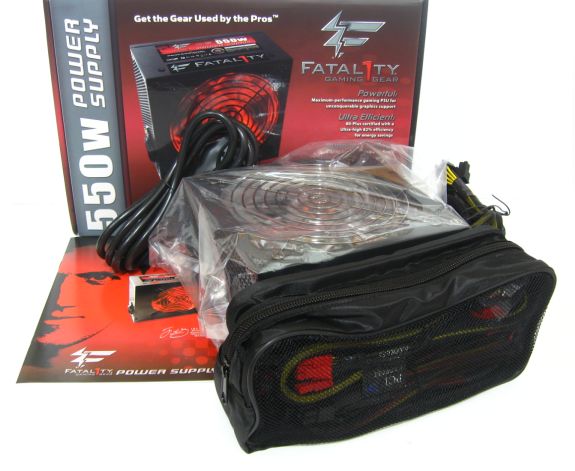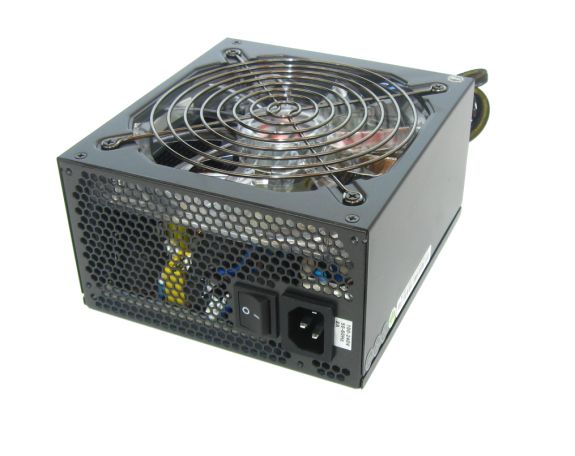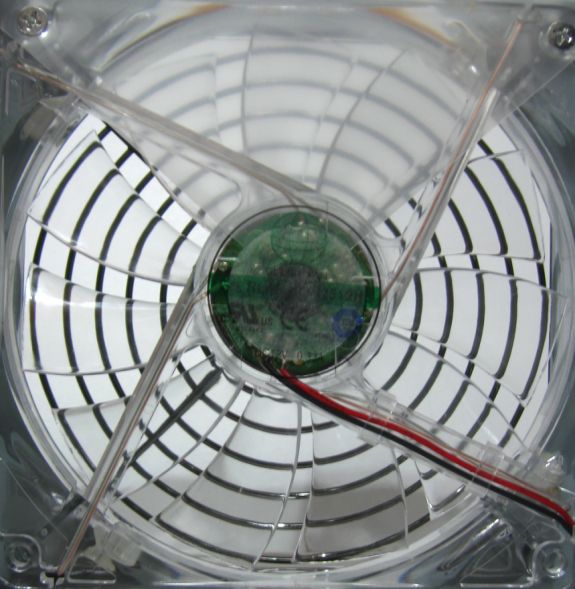550W Roundup: Three PSUs at Different Prices
by Martin Kaffei on October 28, 2010 4:00 PM ESTOCZ Fatal1ty OCZ550FTY
The OCZ Fatal1ty comes with the usual assortment of parts: you get a users manual, a US/UK/Europe power cord (depending on your location), and the necessary mounting screws. In addition, the power supply has cable management ("EZMod Technology for custom cabling"), and the modular cables are placed in a separate bag. The distinctive product features consist of a red LED-fan and active PFC—the latter is not that remarkable, but it's a step up from budget PSUs like the Techsolo. OCZ also makes mention of the 135mm fan and 80 Plus certification. The marketing tells us to "get the Gear used by the Pros", referencing the infamous John "Fatal1ty" Wendel of Quake 3 fame [Ed: has he even done much recently?], and we can only hope the pros use high quality power supplies. OCZ offers a 3-year-warranty with support in their forums.
The varnish is shiny, the ventilation holes are tiny, and when the fan is off you can see almost transparant fan blades and parts of the internal design. The depth of the housing is 16cm, which is okay for a 550W power supply with cable management. There is a large power switch in front of the PSU, but no need to mention this as a feature on the packaging.
| Cables and Connectors | ||
| Fixed/Modular | Main | 24-pin 45cm |
| ATX12V/EPS12V | 4+4-pin 45cm / 4-pin 45cm | |
| PCIe | 6/8-pin 50cm / 6-pin 50cm | |
| Peripheral | 3x PATA 45-75cm / 3x PATA 45-75cm + Floppy 15cm | |
| 3x SATA 45-75cm / 3x SATA 45-75cm | ||
The main cables could be longer than 45cm for use in large cases, but this will work fine otherwise. The 4+4-pin ATX12V and one more 4-pin ATX12V is not bad for a 550W PSU. Six SATA and six Molex connectors are more than enough for common PC configurations, and the floppy connector increases the maxmium cable lenght up to 90cm (but only if you need a mini-4-pin Molex, obviously). Finally, the 6/8-pin and 6-pin PEG connectors make for a reasonable 550W PSU setup.
OCZ continues to use a Globe Fan fan with a double ball bearing, which is partially covered by ducting. The fan needs 0.33 amps and has eleven transparent fan blades.













82 Comments
View All Comments
Phaedrus2129 - Friday, October 29, 2010 - link
Except many of the highest-quality units are only of moderate weight due to requiring fewer components; and some of the crappiest units are now being sold with iron weights inside to make them heavier.Weight is a very poor test, actually opening the power supply up and looking with a critical eye is a thousand times better. I would disregard entirely any reviewer who uses weight as a factor in evaluating PSU quality.
sprockkets - Friday, October 29, 2010 - link
If it is such a poor test, why not then compare the weight and find out?It isn't as poor as you want it to be for arguments sake.
Phaedrus2129 - Friday, October 29, 2010 - link
Then all the PSUs with passive power factor correction would be hailed the best because of the weight added by the massive PFC coil. Vs. APFC units with lighter, but more effective components (couple switching transistors, a small coil, shares the primary capacitor, and a controller IC, still weighs less than a PPFC coil).sprockkets - Friday, October 29, 2010 - link
Bud, it's just a simple metric. Like you know, how a standard InWin PowerMan 350w PS weighs 2 lbs 10 oz and a standard FSP 300w power supply weights 3 lbs 5 oz.Besides, I wouldn't compare a passive vs. active PFC power supply anyhow and make that mistake.
Phaedrus2129 - Saturday, October 30, 2010 - link
I can see just recording the weight for posterity's sake, but one should *not* use weight as a metric of quality or performance. All more weight indicates is more components, heavier heatsinks, thicker wiring, heavier housing. For making a split-second field judgment, sure, but it is made completely redundant by opening the power supply up to appraise components and quality.I can tell far more about a PSU's quality from a quick glance at the secondary-side rectifiers than from measuring its weight.
Stuka87 - Friday, October 29, 2010 - link
I really liked seeing the comparison of the three. I would have liked to of seen a 4th super high end PSu thrown in, but it may have been a bit redundant.As for the low end, there are certainly better supplies out there for that price. You can even get lower end Antec's (like the 430 Basiq) for the same price as the one that blew up and while its not as good as the better Antec's, its better than the chinese no-name stuff.
benedict - Friday, October 29, 2010 - link
The review is clearly biased towards the higher-end PSUs. I don't dare say the reviewer deliberately picked a very poor part just to prove his point. There are some very decent PSUs for 30-40 euro that don't blow up at 50% load. For example, the FSP Saga II achieves 80%+ efficiency, costs about 40 euro and is very silent. Please, show some real part in the value price section and not some handpicked garbage.Phaedrus2129 - Friday, October 29, 2010 - link
This unit is actually above average for "garbage" power supplies. If he were intentionally picking a terrible PSU he'd choose something from Leadman, or Sunpro, that will blow up at 250W and have ripple in the 300mV+ range on all rails.marvdmartian - Friday, October 29, 2010 - link
In almost 10 years now of building my own systems, I have only ever been 'stung' by 2 power supplies. Both of them were Antecs, which died long before they should have, and both of them took out a motherboard while they were at it.Needless to say, I'm somewhat reluctant to ever trust an Antec psu to power my systems. Fool me twice, shame on me......fool me 3 times? I don't think so!!
OCZ would get my vote in this competition, hands down.
mmatis - Friday, October 29, 2010 - link
Especially since NewEgg is offering it with a $15 MIR through 31 October. It has 433 reviews on their site and gets 5 eggs.